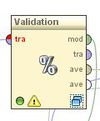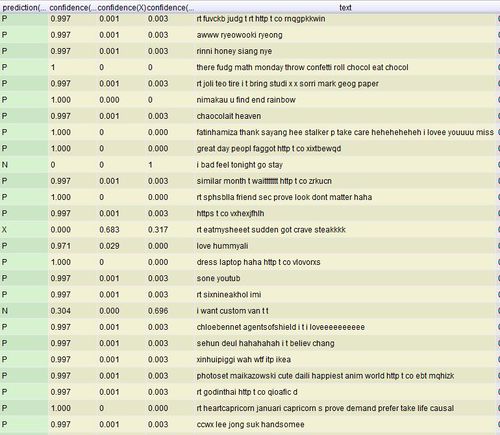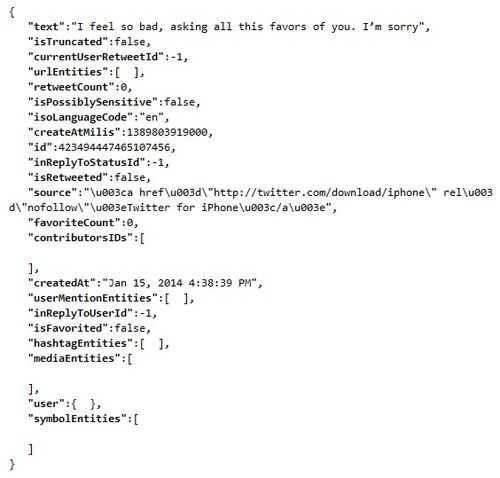Social Media & Public Opinion - Final
Contents
- 1 Change in project scope
- 2 Methodology: Text analytics using Rapidminer
- 3 Pitfalls of using conventional text analysis on social media data
- 4 Improving the effectiveness of sentiment analysis of social media data
- 5
- 6 Limitations & Assumptions
- 7 Future extension
- 8 Acknowledgement & credit
- 9 References
Change in project scope
Having consulted with our professor, we have decided to shift our focus away from developing a dashboard and delve into the subject of text analysis of social media data, or Twitter data. Social media has changed the way how consumers provide feedback to the products they consume. Much social media data can be mined, analysed and turn into value propositions for change in ways companies brand themselves. Although anyone and everyone can easily attain such data, there are certain challenges faced that can hamper the effectiveness of analysis. Through this project, we are going to see what are some of these challenges and way in which we can overcome them.
Methodology: Text analytics using Rapidminer
Setting up Rapidminer for text analysis
Download Rapidminer from here
Defining a standard
Before we can create a model for classifying tweets based on their polarity, we have to first define a standard for the classifier to learn from. To attain this standard, we manually tag a random sample of 1000 tweets with 3 categories; Positive (P), Negative (N) and Neutral (X).
With the tweets and their respective classification, we were ready to create a model for machine learning of tweets sentiments.
Creating the model
 |
|
 |
|
 |
|
 |
|
 |
|
 |
1.Tokenizing the tweet by word Tokenization is the process of breaking a stream of text up into words or other meaningful elements called tokens to explore words in a sentence. Punctuation marks as well as other characters like brackets, hyphens, etc are removed. 2.Converting words to lowercase All words are transformed to lowercase as the same word would be counted differently if it was in uppercase vs. lowercase. 3.Eliminating stopwords The most common words such as prepositions, articles and pronouns are eliminated as it helps to improve system performance and reduces text data. 4.Filtering tokens that are smaller than 3 letters in length Filters tokens based on their length (i.e. the number of characters they contain). We set a minimum number of characters to be 3. 5.Stemming using Porter2’s stemmer Stemming is a technique for the reduction of words into their stems, base or root. When words are stemmed, we are keeping the core of the characters which convey effectively the same meaning. We use the default go-to Porter stemmer. |
 |
|
 |
|
 |
|
 |
|
 |
|
Improving accuracy
One of the ways to improve the accuracy of the model is to remove words that does not appear frequently within the given set of documents. By removing these words, we can ensure that the resulting words that are classified are mentioned a significant number of times. However, the challenge would be to determine what is the number of occurrences required before a word can be taken into account for classification. It is important to note that the higher the threshold, the smaller the resultant word list would be.
We experimented with multiple values to determine the most appropriate amount of words to be pruned off, bearing in mind that we need a sizeable number of words with a high enough accuracy yield
- Percentage pruned refers to the words that are removed from the wordlist that do not occur within the said amount of documents. eg. for 1% pruned out of the set of 1000 documents, words that appeared in less than 10 documents are removed from the wordlist.
| Percentage Pruned | Percentage Accuracy | Deviation | Size of resulting word list |
|---|---|---|---|
| 0% | 39.3% | 5.24% | 3833 |
| 0.5% | 44.2% | 4.87% | 153 |
| 1% | 42.2% | 2.68% | 47 |
| 2% | 45.1% | 1.66% | 15 |
| 5% | 43.3% | 2.98% | 1 |
From the results, we could infer that a large number of words (3680) appears only in less than 5 documents as we see the resulting size of the word list falls from 3833 to 153 when we set the percentage pruned at 0.5%
Pitfalls of using conventional text analysis on social media data
Multiple languages
Misspelled words and abbrevations
Length of status
Other media types
Improving the effectiveness of sentiment analysis of social media data
Allowing the user to tag their feelings to their status
One of the ways in which Facebook may make such analysis easier is by allowing the user to specify how he/she is feeling at the moment of posting a status. With this option, Facebook has effectively increase the probability of determining the right sentiment of the user at the point in time. This mitigates the possibility of sarcasm or other inferred sentiments within that post itself
Limitations & Assumptions
| Limitations | Assumptions |
| Insufficient predicted information on the users (location, age etc.) | Data given by LARC is sufficiently accurate for the user |
| Fake Twitter users | LARC will determine whether or not the users are real or not |
| Ambiguity of the emotions | Emotions given by the dictionary (as instructed by LARC) is conclusive for the Tweets that is provided |
| Dictionary words limited to the ones instructed by LARC | A comprehensive study has been done to come up with the dictionary |
Future extension
- Scalable larger sets of data without hindering on time and performance
- Able to accommodate real-time data to provide instantaneous analytics on-the-go
Acknowledgement & credit
- Dodds PS, Harris KD, Kloumann IM, Bliss CA, Danforth CM (2011) Temporal Patterns of Happiness and Information in a Global Social Network: Hedonometrics and Twitter. PLoS ONE 6(12)
- Companion website: http://hedonometer.org/
- Schwartz HA, Eichstaedt J, Kern M, Dziurzynski L, Agrawal M, Park G, Lakshmikanth S, Jha S, Seligman M, Ungar L. (2013) Characterizing Geographic Variation in Well-Being Using Tweets. ICWSM, 2013
- Helliwell J, Layard R, Sachs J (2013) World Happiness Report 2013. United Nations Sustainable Development Solutions Network.
- Bollen J, Mao H, Zeng X (2010) Twitter mood predict the stock market. Journal of Computational Science 2(1)
- Happy Planet Index

